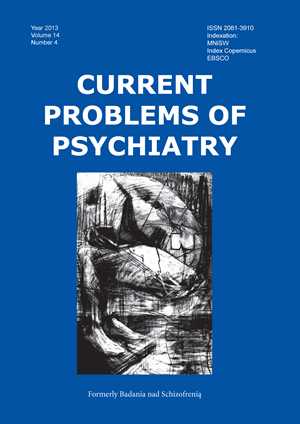Selenium and its role in medicine with special regard to psychical disorders
Słowa kluczowe:
selenium, mental disordersAbstrakt
Since the end of 1950s the knowledge about biological role of the selenium compounds has been steadily growing. Along with the development of biochemistry and molecular biology, there is more and more evidence pointing out to incredibly significant role of the selenium compounds in the cell metabolism processes. The analyses covering the protective properties of selenium concerning the phenomenon of oxidative stress seem to be particularly important from the point of view of the research on broadly understood etiology of neoplastic, inflammatory, degenerative and genetic processes as well as the immunological disorders.
The aim of this work is to present the recent scientific findings discussing the most important directions of the research on the physiological role of selenium compounds and their influence on the occurrence of the human organism structure and functioning with special regard to the disorders concerning the central nervous system. Selenium, being the component of the centers of active enzymes such as gluthatione peroxidase, is necessary for the proper course of numerous enzymatic processes. The significance of selenium is also frequently emphasized in the prophylactics of cancers, diseases of the cardio-vascular system and rheumatic diseases. This paper focuses on the main directions of the research on the pathogenetic and therapeutic role of selenium compounds in affective diseases, schizophrenia, autism, disorders of cognitive functions connected i.e. with Alzheimer’s disease. Undoubtedly the vital fact is that there has been discovered an intensified gene expression for SELENBP-1 protein in the experimental animals in which the states were induced that may constitute the model of psychotic and affective disorders.
Bibliografia
1. Puzanowska-Tarasiewicz H., Kuźmicka L., Tarasiewicz M.: Funkcje biologiczne pierwiastków i ich związków. II. Selen, seleniany, związki selenoorganiczne. Pol. Merk. Lek., 2009; XXVII: 159, 249
2. Gao S., Jin Y., Unverzagt F.W., Liang C., Hall K.S., Cao J., Ma F., Murrell J.R., Cheng Y., Li P., Bian J., Hendrie H.C.: Selenium level and depressive symptoms in a rural elderly Chinese cohort. BMC Psychiatry, 2012; 12: 72.
3. Pasco J.A., Jacka F.N., Williams L.J., Evans-Cleverdon M., Brennan S.L., Kotowicz M.A., Nicholson G.C., Ball M.J., Berk M.: Dietary selenium and major depression: a nested case-control study. Complement Ther Med., 2012; 20(3): 119-23.
4. Berr C., Arnaud J., Akbaraly T.N.: Selenium and cognitive impairment: a brief-review based on results from the EVA study. Biofactors., 2012; 38(2): 139-44.
5. Vural H., Demirin H., Kara Y., Eren I., Delibas N.: Alterations of plasma magnesium, copper, zinc, iron and selenium concentrations and some related erythrocyte anti-oxidant enzyme activities in patients with Alzheimer’s disease. J Trace Elem Med Biol., 2010; 24(3): 169-73.
6. Lakshmi Priya M.D., Geetha A.: Level of trace elements (copper, zinc, magnesium and selenium) and toxic elements (lead and mercury) in the hair and nail of children with autism. Biol Trace Elem Res., 2011; 142(2): 148-58.
7. Cemek M., Büyükokuroğlu M.E., Hazman O., Konuk M., Bulut S., Birdane Y.O.: The roles of melatonin and vitamin E plus selenium in prevention of oxidative stress induced by naloxone-precipitated withdrawal in heroin-addicted rats. Biol Trace Elem Res., 2011; 142(1): 55-66.
8. Machado M. S.,Rosa R. M., Dantas A.S.,Reolon G. K.,Appelt H. R., Braga A. L., Pegas Henriques J. A., Roesler R.:An organic selenium compound attenuates apomorphine-induced stereotypy in mice. Neuroscience Letters, 2006; 410: 198-202
9. Brüning C.A., Prigol M., Luchese C., Pinton S., Nogueira C.W.:Diphenyl diselenide ameliorates behavioral and oxidative parameters in an animal model of mania induced by ouabain. Progress in Neuro-Psychofarm. and Biol. Psychiatry, 2012; 38(2): 168-174
10. Kanazawa T., Chana G., Glatt S.J., Mizuno H., Masliah E., Yoneda H., Tsuang M.T., Everall I.P.:The utility of selenbp1 gene expression as a biomarker for major psychotic disorders: Replication in schizophreniaand extension to bipolar disorder with psychosis, 2008; 147(6): 686-689


